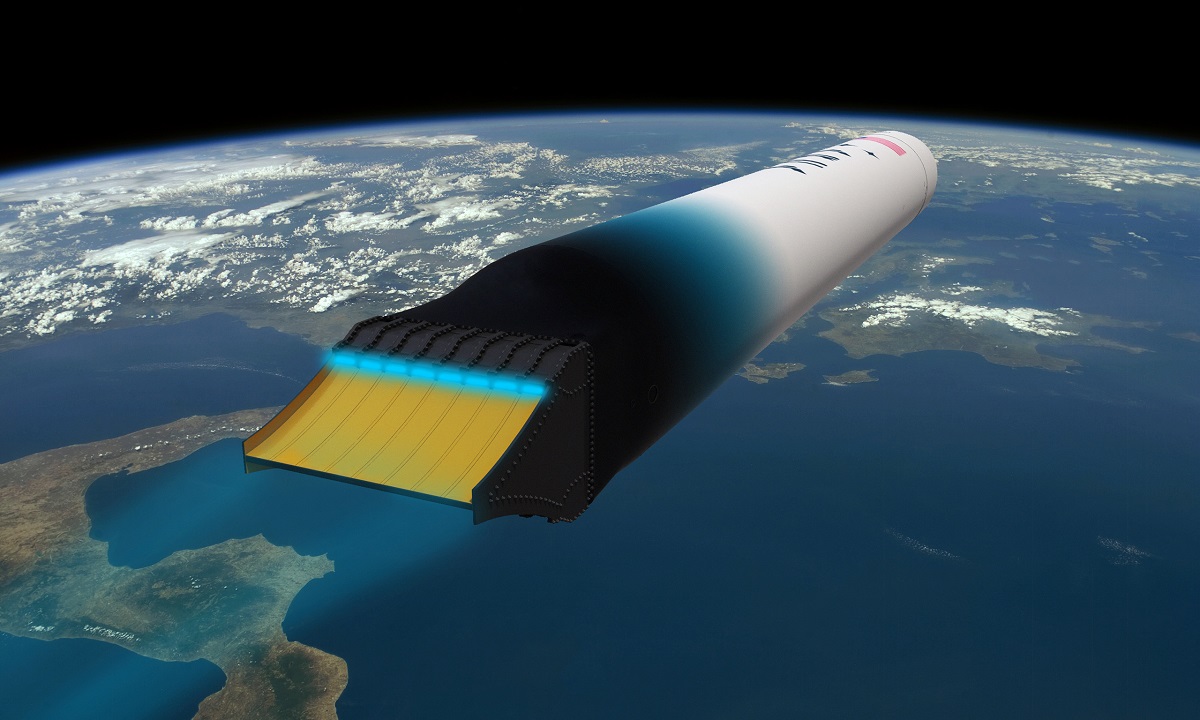Since the beginning of the Space Age, scientists have relied on multi-stage rockets in order to put spacecraft and payloads into orbit. The same technology has allowed for missions farther into space, sending robotic spacecraft to every planet in the Solar System, and astronauts to the Moon. But looking to the future, it is clear that new ideas will be needed in order to cut costs and expand launch services.
Hence why the
ARCA Space Corporation
has developed a concept for a single-stage-to-orbit (SSTO) rocket. It's known as the
Haas 2CA
, the latest in a series of rockets being developed by the New Mexico-based aerospace company. If all goes as planned, this rocket will be the first SSTO rocket in history, meaning it will be able to place payloads and crew into Earth's orbit relying on only one stage with one engine.
The rocket was unveiled on Tuesday, March 28th, at their company headquarters in Las Cruces. The rocket is currently seeking FAA approval, and ARCA is working diligently to get it ready for its test launch in 2018 - which will take place at NASA's
Wallops Flight Facility
located on Virginia's eastern shore. If successful, the company hopes to use this rocket to deploy small satellites to orbit in the coming decade.
[caption id="attachment_134816" align="aligncenter" width="580"]
Artist's impression of the Haas 2C rocket ascending into orbit. Credit: ARCA
[/caption]
Established in 1999 by a group of Romanian rocket enthusiasts (led by company CEO Dumitru Popescu), ARCA's original focus was on balloon-launched rockets. In the course of the company's history, ARCA has launched two stratospheric rockets, four large scale stratospheric balloons, and has been awarded some lucrative governmental contracts to test aerospace and space exploration technologies.
In 2003, the company joined the $10 million
Ansari X Prize Competition
and began work on their first demonstrator rocket. Known as the Demonstrator 2B - a single stage suborbital rocket - the rocket was successfully launched on September 9th, 2004, from Cape Midia Air Force Base. In the years that followed, they expanded their repertoire to include other concepts - like the
Helen
rocket, the
Stabilo
crewed vehicle, and the
Excelsior Aerospike
.
In 2013, ARCA was contracted by the European Space Agency (ESA) to create a Drop Test Vehicle (DTV) that would test the atmospheric deceleration parachutes being used by the
Schiaperelli
lander (as part of the
ExoMars
mission). Being the same weight and using the same parachute deployment systems as
Schiaperelli
, the DTV conducted a freefall exercise which simulated the dynamic pressure conditions of entering the Martian atmosphere
In that same year, ARCA relocated to New Mexico, where they have continued working on their rocket series and other aerospace ventures from their headquarters at the Las Cruces Airport. It was here that they introduced the Haas rocket series - named in honor of Austrian-Romanian rocketry pioneer Conrad Haas - which now consists of the Haas 2B and 2C rockets.
[caption id="attachment_134813" align="aligncenter" width="580"]
The Haas 2CA rocket berthed at ARCA's headqaurters at Las Cruces Air Port in Las Cruces, New Mexico. Credit: ARCA
[/caption]
The 2B is a proven concept, designed for suborbital flight for the sake of space tourism. But as of this week, the 2C is now part of ARCA's rocket family. Relying on single stage and single Executor engine, this rocket will small satellites into orbit. The rocket is fueled by hydrogen peroxide and kerosene (which combines to create a nontoxic fuel), and measures (53 feet) long and (5 feet) in diameter.
The 2C weights about 550 kg (1210 pounds) empty, and 16280 kg (35,887 pounds) when fully fueled. It will also be able to provide 22900 kg (50,500 lbs) of thrust at sea level, and about 33,565 kg (74,000 lbs) in a vacuum. In this configuration, the rocket is capable of delivering100kg (220lbs) to Low Earth Orbit (LEO), at a cost of $1 million per launch (or $10,000/kg; $4,545/lb).
This several times less what SpaceX can do with its Falcon 9* rocket, which can deliver 22,800 km payloads to orbit for $62 million a launch - which works out to about $2719/kg or $1233/lb. However, one must take into account that the Falcon 9* is a heavier launch vehicle, and that there are additional issues that come into play where larger launch vehicles are concerned. As Dumitru Popescu told Universe Today via email:
[caption id="attachment_134815" align="aligncenter" width="580"]
Artist's impression of the Haas 2C rocket, shown in its launch (top) and deployment configurations (bottom). Credit: ARCA
[/caption]
In addition, the Haas 2C rocket benefits from the fact that it is cheaper and easier to manufacture, and that it's SSTO configuration offers greater flexibility and reliability.
"In the case of staged rockets, we are literally talking about more rockets combined in one vehicle to achieve orbit," said Popsecu. "It is definitely more cost effective to operate one rocket than a vehicle made of multiple rockets, as it requires less time, less qualified manpower and less demanding transport and launch operations. The SSTO may also offer the possibility to launch from an inland spaceport, as there are no first stages that will fall on the ground after burnout."
To prepare the rocket for its 2018 launch, ARCA is currently collaborating with NASA through its Cooperative Opportunity Program and with the help of the Ames, Kennedy, Marshall, Stennis, and Johnson Space Centers. Popescu is also entering into discussions with the
New Mexico Spaceport Authority
to conduct launches from Spaceport America, and is looking to secure a partnership with a US defense agency.
If all goes well, this little aerospace company will be making spaceflight history. As Popescu said in a company press release:
In addition, the aerospace industry will have another company looking to lower the costs of launches and expanding domestic launch capability. Be sure to check out the company's video detailing the Haas 2C and its unique characteristics:
Further Reading: ARCA
 Universe Today
Universe Today
